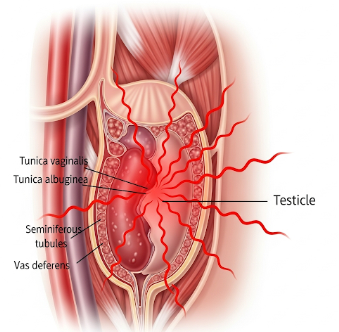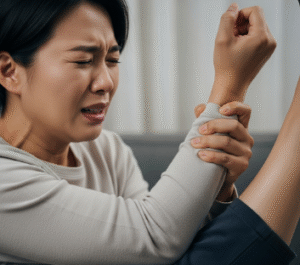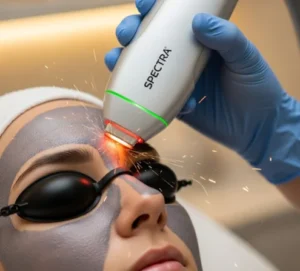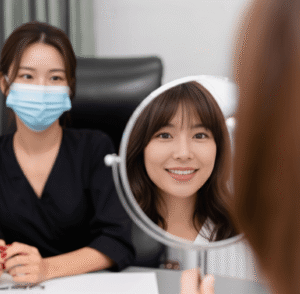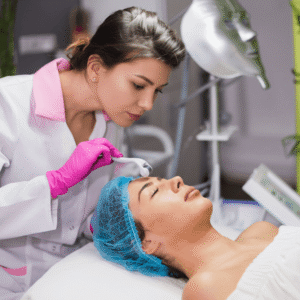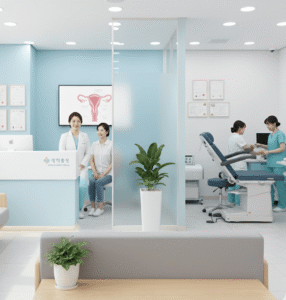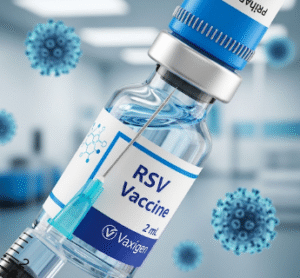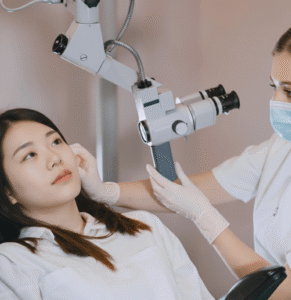➤ Overview
Testicle pain, also known as orchialgia, refers to discomfort or pain in one or both testicles. This pain can range from mild and intermittent to severe and acute, affecting daily activities, mobility, and overall quality of life. Testicle pain may be localized to the testes or radiate to the groin, lower abdomen, or lower back, depending on the underlying cause.
In South Korea, testicle pain is evaluated by urologists and andrologists using physical examination, imaging, and laboratory tests. Early diagnosis is critical to prevent complications, preserve fertility, and address serious conditions like testicular torsion or infection.
➤ Key Facts
→ Testicle pain may be acute or chronic, lasting hours to months.
→ Causes can be infectious, inflammatory, traumatic, or vascular.
→ Pain may be unilateral (one testicle) or bilateral (both testicles).
→ Acute severe pain may indicate emergency conditions like testicular torsion.
→ Chronic pain may affect fertility, sexual function, and quality of life.
→ In Korea, ultrasound and lab tests are standard for accurate diagnosis.
→ Prompt treatment improves outcomes and prevents long-term complications.
➤ What is Testicle Pain?
Testicle pain is a symptom rather than a disease, indicating underlying abnormalities in the testicles, epididymis, or surrounding structures:
→ Acute pain – Often sudden, severe, and may be accompanied by swelling or redness.
→ Chronic pain – Persistent or intermittent discomfort lasting more than 3 months.
→ Referred pain – Pain may radiate to the groin, lower abdomen, or back.
→ Associated scrotal changes – Swelling, redness, warmth, or palpable lumps.
→ Indicator of underlying pathology – Infection, torsion, trauma, hernia, or tumor.
→ Functional impact – May interfere with walking, exercise, sitting, or sexual activity.
➤ What Symptoms are Related to Testicle Pain?
Symptoms vary depending on cause and severity:
→ Swelling or tenderness → Localized to the affected testicle.
→ Redness or warmth → Suggestive of infection or inflammation.
→ Fever or malaise → Often present with epididymitis or orchitis.
→ Nausea or vomiting → Associated with acute testicular torsion or severe infection.
→ Pain during urination or ejaculation → Common in infections or inflammation.
→ Palpable lumps or irregularities → May indicate cysts, tumors, or hernias.
→ Radiating discomfort → Pain may extend to the groin, lower abdomen, or back.
→ Changes in testicle size or shape → Asymmetry may suggest pathology.
➤ What Causes / Possible Causes?
Testicle pain can arise from infectious, inflammatory, traumatic, vascular, or systemic causes:
→ Epididymitis – Inflammation of the epididymis, often due to bacterial or sexually transmitted infections.
→ Orchitis – Testicular inflammation, sometimes viral (e.g., mumps).
→ Testicular torsion – Emergency condition where the spermatic cord twists, cutting off blood supply.
→ Trauma or injury – Direct impact, contusions, or hematomas.
→ Varicocele – Enlarged veins in the scrotum causing chronic discomfort.
→ Hydrocele – Fluid accumulation around the testicle, occasionally painful.
→ Hernia – Indirect inguinal hernia may cause radiating testicular pain.
→ Testicular cancer – Often painless initially but may present with discomfort or heaviness.
→ Systemic conditions – Kidney stones or referred pain from lower back injuries.
→ Idiopathic chronic orchialgia – Pain without identifiable cause.
➤ When Should I See My Doctor?
Immediate medical evaluation is required if any of the following occur:
→ Sudden, severe testicle pain – Could indicate testicular torsion, a medical emergency.
→ Swelling, redness, or warmth – Suggestive of infection requiring urgent treatment.
→ Fever or systemic symptoms – Indicates infection or inflammation.
→ Palpable lumps or irregularities – Rule out tumors or cysts.
→ Persistent or recurrent pain – Chronic orchialgia needs evaluation.
→ Pain after trauma – To rule out hematoma or rupture.
→ In Korea, urologists use ultrasound, lab tests, and physical exams to determine the exact cause and guide treatment.
➤ Care and Treatment
Treatment depends on cause, severity, and duration of pain:
→ Pain management – NSAIDs or acetaminophen for mild to moderate discomfort.
→ Antibiotics – For bacterial infections, including sexually transmitted infections.
→ Supportive measures – Scrotal elevation, ice packs, and rest.
→ Surgery – Required for testicular torsion, severe varicocele, hernia repair, or tumor removal.
→ Chronic pain management – Physical therapy, nerve blocks, or medication for idiopathic orchialgia.
→ Lifestyle modifications – Avoid heavy lifting or strenuous activity until resolved.
→ Follow-up evaluation – Monitor response to treatment and prevent recurrence.
→ Fertility considerations – Assessment may be required if chronic infection or surgery affects reproductive function.
➤ Treatment Options in Korea
South Korea provides advanced diagnostic and therapeutic services for testicle pain:
Diagnosis in Korea
→ Scrotal ultrasound – Detects structural abnormalities, cysts, tumors, or fluid collections.
→ Laboratory tests – Blood tests, urine analysis, and STI testing.
→ Physical examination by urologists – Assess tenderness, swelling, and lumps.
→ Advanced imaging – MRI or CT for complex or unclear cases.
Medical Treatments in Korea
→ Antibiotics – Target bacterial or sexually transmitted infections.
→ Pain relief medications – NSAIDs or acetaminophen for symptom control.
→ Supportive care – Scrotal elevation, rest, and ice therapy.
Surgical and Advanced Therapies in Korea
→ Orchidopexy – Emergency surgery for testicular torsion.
→ Varicocelectomy – Surgical repair of enlarged veins.
→ Hydrocelectomy – Removal of fluid-filled sacs.
→ Orchiectomy – Removal of the testicle in cases of malignancy.
→ Multidisciplinary care – Collaboration between urology, infectious disease, and reproductive specialists.
Rehabilitation & Support in Korea
→ Post-treatment monitoring for pain relief and functional recovery.
→ Guidance on fertility, sexual health, and lifestyle adjustments.
→ Patient education on early recognition, self-examination, and prevention of recurrence.

